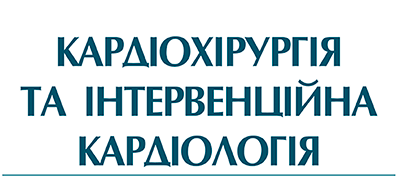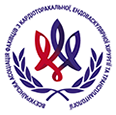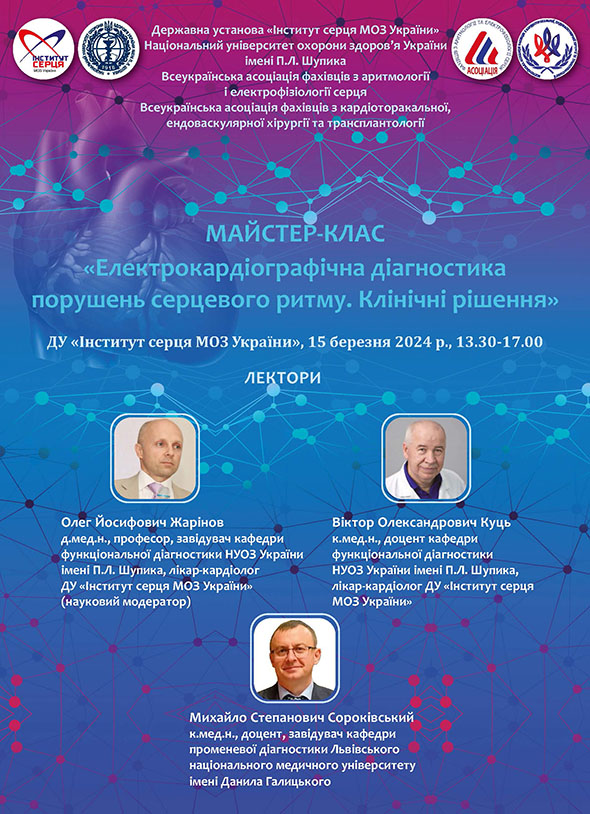Причини та фактори ризику розвитку рестенозу стента у хворих після черезшкірних коронарних втручань
М.П. Копиця, І.М. Кутя, Ю.В. Родіонова, Я.В. Гільова, Н.В. Титаренко
Література
- Alfonso F, Bastante T, Antuña P, de la Cuerda F, Cuesta J, García-Guimaraes M, Rivero F. Coronary lithoplasty for the treatment of undilatable calcified de novo and in-stent restenosis lesions. JACC Cardiovasc Interv. 2019;12:497-9. doi: 10.1016/j.jcin.2018.12.025.
- Alfonso F, Byrne RA, Rivero F, Kastrati A. Current treatment of in-stent restenosis. J Am Coll Cardiol. 2014;63:2659-73. doi: 10.1016/j.jacc. 2014.02.545.
- Asahara T, Takahashi T, Masuda H, Kalka C, Chen D, Iwaguro H, Inai Y, Silver M, Isner JM. VEGF contributes to postnatal neovascularization by mobilizing bone marrow-derived endothelial progenitor cells. EMBO J. 1999;18(14):3964-72. doi: 10.1093/emboj/18.14.3964.
- Bagyura Z, Kiss L, Hirschberg K, Berta B, Széplaki G, Lux Á, Szelid Z, Soós P, Merkely B. Association between VEGF Gene Polymorphisms and In-Stent Restenosis after Coronary Intervention Treated with Bare Metal Stent. Dis Markers. 2017;2017:9548-612. doi: 10.1155/2017/9548612.
- Berenguer A, Mainar V, Bordes P, Valencia J, Gomez S, Lozano T. Incidence and predictors of restenosis after sirolimus-eluting stent implantation in high-risk patients. Am Heart J. 2005;150:536-42.
- Chan AW MD. Clinical Evaluation of Restenosis // Atherothrombosis and coronary artery disease / Fuster V, Topol EJ, Nabel EG, ed. Philadelphia: Lippincott Williams & Wilkins, 2004. P. 1415-41.
- Chen HJ, Mo N, Zhang YF, Su GZ, Wu HD, Pei F. Role of Gene Polymorphisms/Haplotypes and Plasma Level of TGF-β1 in Susceptibility to In-Stent Restenosis Following Coronary Implantation of Bare Metal Stent in Chinese Han Patients. Int Heart J. 2018;59(1):161-9. doi: 10.1536/ihj.17-190.
- Chen MS, John JM, Chew DP, Lee DS, Ellis SG, Bhatt DL. Bare metal stent restenosis is not a benign clinical entity. Am Heart J. 2006;151(6):1260-4. doi: 10.1016/j.ahj.2005.08.011.
- Cheng G, Chang FJ, Wang Y, You PH, Chen HC, Han WQ, Wang JW, Zhong NE, Min ZQ. Factors Influencing Stent Restenosis After Percutaneous Coronary Intervention in Patients with Coronary Heart Disease: A Clinical Trial Based on 1-Year Follow-Up. Med Sci Monit. 2019;25:240-7. doi: 10.12659/MSM.908692.
- Cho JY. Identification of Risk Factors Influencing In-Stent Restenosis with Acute Coronary Syndrome Presentation. Chonnam Med J. 2017; 53:203-21. doi: 10.4068/cmj.2017.53.3.203.
- Christen T, Verin V, Bochaton-Piallat M, Popowski Y, Ramaekers F, Debruyne P, Camenzind E, van Eys G, Gabbiani G. Mechanisms of neointima formation and remodeling in the porcine coronary artery. Circulation. 2001;103(6):882-8. doi: 10.1161/01.cir.103.6.882.
- Chung WS, Park CS, Seung KB, Kim PJ, Lee JM, Koo BK, Jang YS, Yang JY, Yoon JH, Kim DI, Yoon YW, Park JS, Cho YH, Park SJ. The incidence and clinical impact of stent strut fractures developed after drug-eluting stent implantation. Int J Cardiol. 2008;125:325-31. doi: 10.1016/j.ijcard.2007.02.033.
- Dangas GD, Claessen BE, Caixeta A, Sanidas EA, Mintz GS, Mehran R. In-stent restenosis in the drug-eluting stent era. J Am Coll Cardiol. 2010;56(23):1897-907. doi: 10.1016/j.jacc.2010.07.028.
- Ding M, Rzucidlo EM, Davey JC, Xie Y, Liu R, Jin Y, Stavola L, Martin KA. Adiponectin in the heart and vascular system. Vitam Horm. 2012;90:289-319. doi: 10.1016/B978-0-12-398313-8.00011-7.
- Donners MM, Daemen MJ, Cleutjens KB, Heeneman S. Inflammation and restenosis: implications for therapy. Ann Med. 2003;35(7):523-31. doi: 10.1080/07853890310014876.
- Fujino A, Mintz GS, Matsumura M, Lee T, Kim SY, Hoshino M, Usui E, Yonetsu T, Haag ES, Shlofmitz RA, Kakuta T, Maehara A. A new optical coherence tomography-based calcium scoring system to predict stent underexpansion. EuroIntervention. 2018;13:e2182-9. doi: 10.4244/EIJ-D-17-00962.
- Garcia R, Bouleti C, Sirol M, Logeart D, Monnot C, Ardidie-Robouant C, Caligiuri G, Mercadier JJ, Germain S. VEGF-A plasma levels are associated with microvascular obstruction in patients with ST-segment elevation myocardial infarction. Int J Cardiol. 2019;291:19-24. doi: 10.1016/j.ijcard.2019.02.067.
- Gori T. Endothelial Function: A Short Guide for the Interventional Cardiologist. Int J Mol Sci. 2018;19(12):3838. doi: 10.3390/ijms19123838.
- Gori T. Vascular Wall Reactions to Coronary Stents – Clinical Implications for Stent Failure. Life. 2021;11:63. doi: 10.3390/life11010063.
- Goto K, Zhao Z, Matsumura M, Dohi T, Kobayashi N, Kirtane AJ, Rabbani LE, Collins MB, Parikh MA, Kodali SK, Leon MB, Moses JW, Mintz GS, Maehara A. Mechanisms and patterns of intravascular ultrasound in-stent restenosis among bare metal stents and first- and secondgeneration drug-eluting stents. Am J Cardiol. 2015;116:1351-7. doi: 10.1016/j.amjcard.2015.07.058.
- Hutter R, Carrick FE, Valdiviezo C, Wolinsky C, Rudge JS, Wiegand SJ, Fuster V, Badimon JJ, Sauter BV. Vascular endothelial growth factor regulates reendothelialization and neointima formation in a mouse model of arterial injury. Circulation. 2004;110(16):2430-5. doi: 10.1161/01.CIR.0000145120.37891.8A.
- Jiang H, Zhang H, Yang Y, Yang X. Associations of myeloperoxidase, interleukin-17A and heparin-binding EGF-like growth factor levels with in-stent restenosis after percutaneous coronary intervention: a single-centre case-control study in China. BMJ open. 2020;10(11):e039405. doi:10.1136/bmjopen-2020-039405.
- Jinnouchi H, Kuramitsu S, Shinozaki T, Tomoi Y, Hiromasa T, Kobayashi Y, Domei T, Soga Y, Hyodo M, Shirai S, Ando K. Difference of Tissue Characteristics Between Early and Late Restenosis After Second-Generation Drug-Eluting Stents Implantation – An Optical Coherence Tomography Study. Circulation. 2017;81(4):450-7. doi: 10.1253/circj.CJ-16-1069.
- Joner M, Nakazawa G, Finn AV, Quee SC, Coleman L, Acampado E, Wilson PS, Skorija K, Cheng Q, Xu X, Gold HK, Kolodgie FD, Virmani R. Endothelial cell recovery between comparator polymer-based drug-eluting stents. J Am Coll Cardiol. 2008;52(5):333-42. doi: 10.1016/j.jacc.2008.04.030.
- Kastrati A, Dibra A, Mehilli J, Mayer S, Pinieck S, Pache J, Dirschinger J, Schömig A. Predictive factors of restenosis after coronary implantation of sirolimus- or paclitaxel-eluting stents. Circulation. 2006;113(19):2293-300. doi: 10.1161/CIRCULATIONAHA.105.601823.
- Katsaros KM, Kastl SP, Krychtiuk KA, Hutter R, Zorn G, Maurer G, Huber K, Wojta J, Christ G, Speidl WS. An increase of VEGF plasma levels is associated with restenosis of drug-eluting stents. EuroIntervention. 2014;10(2):224-30. doi: 10.4244/EIJV10I2A36.
- Kazmierczak E, Grajek S, Kowal J, Chmara E, Grygier M, Pyda M, Bogdanski P, Cieslewicz A, Jablecka A. Prognostic usefulness of IL-6 and VEGF for the occurrence of changes in coronary arteries of patients with stable angina and implanted stents. Eur Rev Med Pharmacol Sci. 2014;18(15):2169-75.
- Keavney B. Outcome following percutaneous coronary intervention: not, so far, in our genes. Heart. 2003;89(3):247-8. doi: 10.1136/heart.89.3.247.
- Kim MS, Dean LS. In-stent restenosis. Cardiovasc Ther. 2011;29:190–8. doi: 10.1111/j.1755-5922.2010.00155.x
- Koch W, Böttiger C, Mehilli J, Neumann FJ, Schömig A, Kastrati A. Association of a CD18 gene polymorphism with a reduced risk of restenosis after coronary stenting. Am. J. Cardiol. 2001;88(10):1120-4. doi: 10.1016/S0002-9149(01)02045-8.
- Lemos PA, Saia F, Ligthart JM, Arampatzis CA, Sianos G, Tanabe K, Hoye A, Degertekin M, Daemen J, McFadden E, Hofma S, Smits PC, de Feyter P, van der Giessen WJ, van Domburg RT, Serruys PW. Coronary restenosis after sirolimus-eluting stent implantation: morphological description and mechanistic analysis from a consecutive series of cases. Circulation. 2003;108:257-60. doi: 10.1161/01.CIR.0000083366.33686.11
- Li HC, Cao GQ, Liu CZ, Tang MM, Zhang XQ. Gene polymorphism of adiponectin in restenosis after coronary stenting. Eur Rev Med Pharmacol Sci. 2019;23(3 Suppl):287-93. doi: 10.26355/eurrev_201908_18659.
- Mathew V, Gersh BJ, Williams BA, Laskey WK, Willerson JT, Tilbury RT, Davis BR, Holmes DR Jr. Outcomes in patients with diabetes mellitus undergoing percutaneous coronary intervention in the current era: a report from the Prevention of REStenosis with Tranilast and its Outcomes (PRESTO) trial. Circulation. 2004;109(4):476-80. doi: 10.1161/01.CIR.0000109693.64957.20.
- Nakamura D, Yasumura K, Nakamura H, Matsuhiro Y, Yasumoto K, Tanaka A, Matsunaga-Lee Y, Yano M, Yamato M, Egami Y, Shutta R, Sakata Y, Tanouchi J, Nishino M. Different Neoatherosclerosis Patterns in Drug-Eluting- and Bare-Metal Stent Restenosis – Optical Coherence Tomography Study. Circulation. 2019;83(2):313-9. doi: 10.1253/circj.CJ-18-0701.
- Nakamura Y, Shimada K, Fukuda D, Shimada Y, Ehara S, Hirose M, Kataoka T, Kamimori K, Shimodozono S, Kobayashi Y, Yoshiyama M, Takeuchi K, Yoshikawa J. Implications of plasma concentrations of adiponectin in patients with coronary artery disease. Heart. 2004;90(5):528-33. doi: 10.1136/hrt.2003.011114.
- Ohtani K, Egashira K, Hiasa K, Zhao Q, Kitamoto S, Ishibashi M, Usui M, Inoue S, Yonemitsu Y, Sueishi K, Sata M, Shibuya M, Sunagawa K. Blockade of vascular endothelial growth factor suppresses experimental restenosis after intraluminal injury by inhibiting recruitment of monocyte lineage cells. Circulation. 2004;110(16):2444-52. doi: 10.1161/01.CIR.0000145123.85083.66.
- Osadnik T, Strzelczyk JK, Reguła R, Bujak K, Fronczek M, Gonera M, Gawlita M, Wasilewski J, Lekston A, Kurek A, Gierlotka M, Trzeciak P, Hawranek M, Ostrowska Z, Wiczkowski A, Poloński L, Gąsior M. The Relationships between Polymorphisms in Genes Encoding the Growth Factors TGF-β1, PDGFB, EGF, bFGF and VEGF-A and the Restenosis Process in Patients with Stable Coronary Artery Disease Treated with Bare Metal Stent. PLoS One. 2016;11(3):e0150500. doi: 10.1371/journal.pone.0150500.
- Otake H, Shite J, Shinke T, Watanabe S, Tanino Y, Ogasawara D, et al. Relation between plasma adiponectin, high-sensitivity C-reactive protein, and coronary plaque components in patients with acute coronary syndrome. Am J Cardiol. 2008;101:1-7.
- Palmerini T, Biondi-Zoccai G, Della Riva D, Mariani A, Genereux P, Branzi A, Stone GW. Stent thrombosis with drug-eluting stents: is the paradigm shifting? J Am Coll Cardiol. 2013;62(21):1915-21. doi: 10.1016/j.jacc.2013.08.725.
- Parry TJ, Brosius R, Thyagarajan R, Carter D, Argentieri D, Falotico R, Siekierka J. Drug-eluting stents: sirolimus and paclitaxel differentially affect cultured cells and injured arteries. Eur J Pharmacol. 2005;524(1–3):19-29. doi: 10.1016/j.ejphar.2005.09.042.
- Pons D, Monraats PS, de Maat MP, Pires NM, Quax PH, van Vlijmen BJ, Rosendaal FR, Zwinderman AH, Doevendans PA, Waltenberger J, de Winter RJ, Tio RA, Frants RR, van der Laarse A, van der Wall EE, Jukema JW. The influence of established genetic variation in the haemostatic system on clinical restenosis after percutaneous coronary interventions. Thromb Haemost. 2007;98(6):1323-8.
- Schnorbus B, Daiber A, Jurk K, Warnke S, König J, Krahn U, Lackner K, Munzel T, Gori T. Effects of clopidogrel, prasugrel and ticagrelor on endothelial function, inflammatory and oxidative stress parameters and platelet function in patients undergoing coronary artery stenting for an acute coronary syndrome. A randomised, blinded, parallel study. Eur Heart J. 2020;41(33):3144-52. doi:10.1093/eurheartj/ehz917.
- Shlofmitz E, Iantorno M, Waksman R. Restenosis of Drug-Eluting Stents: A New Classification System Based on Disease Mechanism to Guide Treatment and State-of-the-Art Review. Circ Cardiovasc Interv. 2019;12(8):e007023. doi: 10.1161/CIRCINTERVENTIONS.118.007023.
- Stone GW, Ellis SG, Cannon L, Mann JT, Greenberg JD, Spriggs D, O’Shaughnessy CD, DeMaio S, Hall P, Popma JJ, Koglin J, Russell ME; TAXUS V Investigators. Comparison of a polymer-based paclitaxel-eluting stent with a bare metal stent in patients with complex coronary artery disease: a randomized controlled trial. JAMA. 2005;294(10):1215-23. doi: 10.1001/jama.294.10.1215.
- Tiyerili V, Camara B, Becher MU, Schrickel JW, Lütjohann D, Mollenhauer M, Baldus S, Nickenig G, Andrié RP. Neutrophil-derived myeloperoxidase promotes atherogenesis and neointima formation in mice. Int J Cardiol. 2016;204:29-36. doi: 10.1016/j.ijcard.2015.11.128.
- Тsigkas GG, Karantalis V, Hahalis G, Alexopoulos D. Stent restenosis, pathophysiology and treatment options: a 2010 update. Hellenic J Cardiol. 2011;52(2):149-57.
- Verschuren JJ, Trompet S, Postmus I, Sampietro ML, Heijmans BT, Houwing-Duistermaat JJ, Slagboom PE, Jukema JW. Systematic testing of literature reported genetic variation associated with coronary restenosis: results of the GENDER Study. PLoS One. 2012;7(8):e42401. doi: 10.1371/journal.pone.0042401.
- Virmani R, Guagliumi G, Farb A, Musumeci G, Grieco N, Motta T, Mihalcsik L, Tespili M, Valsecchi O, Kolodgie FD. Localized hypersensitivity and late coronary thrombosis secondary to a sirolimus-eluting stent: should we be cautious? Circulation. 2004;109(6):701-5. doi: 10.1161/01.CIR.0000116202.41966.D4.
- Xu X, Pandit RU, Han L, Li Y, Guo X. Remnant Lipoprotein Cholesterol Independently Associates With In-Stent Restenosis After Drug-Eluting Stenting for Coronary Artery Disease. Angiology. 2019;70(9):853-9. doi: 10.1177/0003319719854296.
- Yang J, Zeng Y, Zhang C, Chen YX, Yang Z, Li Y, Leng X, Kong D, Wei XQ, Sun HF, Song CX. The prevention of restenosis in vivo with a VEGF gene and paclitaxel co-eluting stent. Biomaterials. 2013;34(6):1635-43. doi: 10.1016/j.biomaterials.2012.11.006.
- Zeng WP, Zhang R, Li R, Luo JF, Hu XF. Association of the Endothelial Nitric Oxide Synthase Gene T786C Polymorphism with In-Stent Restenosis in Chinese Han Patients with Coronary Artery Disease Treated with Drug-Eluting Stent. PLoS One. 2017;12(1):e0170964. doi: 10.1371/journal.pone.0170964.
- Zhang R, Brennan ML, Fu X, Aviles RJ, Pearce GL, Penn MS, Topol EJ, Sprecher DL, Hazen SL. Association between myeloperoxidase levels and risk of coronary artery disease. JAMA. 2001;286(17):2136-42. doi: 10.1001/jama.286.17.2136.
- Zhu X, Chen Y, Xiang L, You T, Jiao Y, Xu W, Chen J. The long-term prognostic significance of high-sensitive C-reactive protein to in-stent restenosis. Medicine (Baltimore). 2018;97(27):e10679. doi: 10.1097/MD.0000000000010679.
| [PDF] | [Зміст журналу] |












